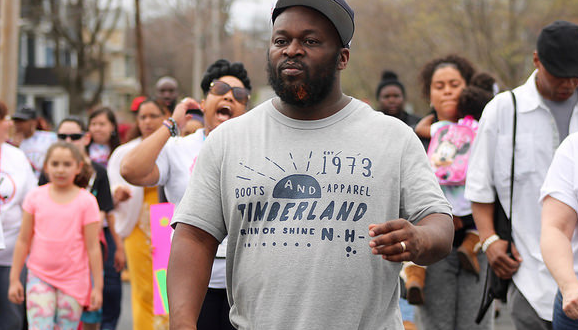Local ‘groundbreaking’ study reveals allure of streets mirrors other behavioral addictions
“The hardest part of my job is hearing the mother’s scream after a homicide.”
Those are the words of Timothy “Noble” Jennings-Bey, director of the Trauma Response Team, whose job is to respond to neighborhood killings and provide help to victim’s families.
“I’m in the business of trying to help people heal and deal with the ghosts,” he explains.
CONFRONTING GHOSTS
In Jennings-Bey’s more than decade working on violence prevention, he’s seen many young men die. He’s seen even more become intoxicated by the street — becoming hard-wired for deviance and showing signs of withdrawal when out of the action. For several years, he’s analyzed the underlying factors that sway these young men to engage in destructive, criminal and violent behavior. He first connected street life to addiction during a class focused on signs of alcohol abuse. He saw the exact behaviors described in his textbook as he saw in the men he encountered with the Trauma Response Team.
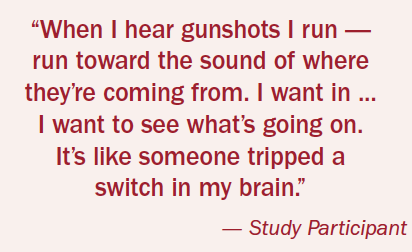 “I didn’t create anything new,” he said of his theory on street addiction. “I just diagnosed it.”
“I didn’t create anything new,” he said of his theory on street addiction. “I just diagnosed it.”
After a presentation on his model last year, a parent thanked him, telling him she would never have looked at her child as having a disease related to the streets.
“She thought something was wrong with her and the way she was parenting,” he said. “So there was joy in that for me because I gave a family comfort, at least psychologically. Now the steps they take after that are up to her and her family but at least she knows there is nothing wrong with her son. He’s not a bad person. He’s not a criminal. He just has an addiction that he has to work through.”
In 2008, Jennings-Bey shared his theory with experts at Syracuse University’s David B. Falk College of Sport and Human Dynamics, partnered with a team there and then co-authored a paper on his hypothesis. Within the past year, he has launched a nonprofit — The Street Addiction Institute, Inc. (SAII) — to start to implement his model for recovery. His strategy with SAII is to address the underlying trauma and show SAII members a different way of thinking. He not only wants to prevent the “ghosts” but also the recidivism rate and traumatic stress accumulating in the neighborhood.
A research team known as the Syracuse Neighborhood Violence Research Network, which includes the collaborative team that published the street addition paper, is also investigating the psychological trauma caused by neighborhood violence, noting for every individual who is physically injured, 200 others are affected. While these others may have no external injuries, developing research reports they may have mental trauma similar to veterans or current civil war refugees suffering from Post Traumatic Stress Disorder, or PTSD.
“Post means that it’s stopped,” Jennings-Bey interjects, noting the one major difference. “With us, it never stops. It’s ongoing. The secondary victims … the ones outside the yellow tape, continue to carry the psychological trauma with them.”
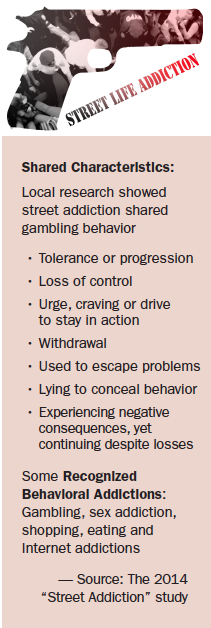 WHAT THE PAPER SAYS
WHAT THE PAPER SAYS
His 2014 study, “Street Addiction: A Proposed Theoretical Model for Understanding the Draw of Street Life and Gang Activity,” defines street addiction as both a physical and psychological need for action with a heightened response to threats or triggers, which could be hearing a gunshot to a perceived verbal threat.
One study participant described it as: “The sight, the smell, the feel, well the memory of how a gun feels in my hands … I mean I’m done with it, but damn there’s a longing there. Bullets, beautiful … tarnished casings .. damn I need a piece. But I resist. I will resist. I have resisted.”
The collaborative paper was published in the 2014 “Journal of Addiction Research and Theory,” after two failed attempts with other journals. Although it is not uncommon for research articles to be declined for one reason or another, acceptance of this theory was especially challenging. “Within the behavioral addictions field, our theory pushed the envelope,” said Dessa Bergen-Cico, lead author on the paper and a professor at SU’s Falk College with expertise on addiction, PTSD and other traumas. “Even when we first started this work, the concept of behavioral addictions was not yet accepted.”
The first submission went out in 2010. “We noted the reviewers’ feedback and expanded the study before resubmitting to the ‘Journal of Behavioral Addictions,’” Bergen-Cico said, noting that the journal itself did not even exist until 2012.
While behavioral addictions, such as substance abuse and gambling, are well-documented now, studies on the behavior of gang activity through the framework of addiction is scarce. The authors report that this paper is the first published work on the theory.
For the paper, Jennings-Bey and community violence and outreach worker Arnett Haygood-El used their established trust in the community to interview a dozen men with histories of gang affiliation and street crime, who anonymously shared their perspectives.
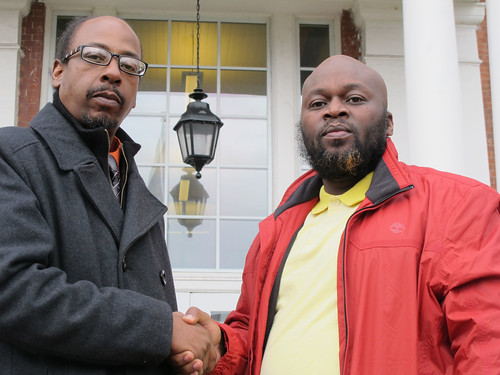
“The study would absolutely not have been possible without them,” said Bergen-Cico, about the pair’s role. “A study like this takes a tremendous amount of trust between the interviewer and the subject, so having those interviews conducted by Noble and Arnett, allowed for (greater insight). Something I would not have been able to achieve.”
Haygood-El and Jennings-Bey both grew up on the South Side and shared similar life experiences as those they interviewed. Haygood-El related because years ago he led that same lifestyle. He dropped out of school at age 15 and says he ran his own crew by 19. By 25, he had three children, had been shot five times and served time for gun possession. Now at 47, he is the public relations specialist for the Trauma Response Team and president of the SAII.
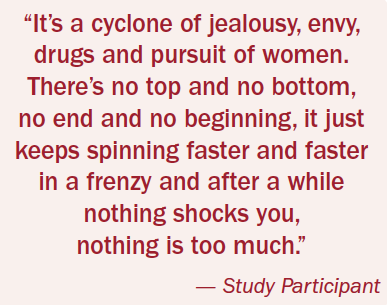
He said for almost a decade he and Jennings-Bey have been tossing around this idea of street addiction and are now working for grants to expand on what they learned through their research. “College was my rehab,” he said about starting at Fredonia State University at age 28. “I started having visions of my death, and it affected my health. I had to do something to make a change. We hope the SAII can help guide these young men sooner.”
Their study determined that with most addictions there is a history of trauma and suffering, resulting in people acting out as a way to handle the buildup of stress. The study showed that the experiences described by interviewees actually mirrored the characteristics of gambling as defined in the Diagnostic and Statistical Manual (DSM-V).
Diane Lyden Murphy, dean of Falk College, described the paper as groundbreaking research during a roundtable discussion held April 11 by the Syracuse Neighborhood Violence Research Network. “To get this into the DMS as a classified behavioral addiction, what would that do? We would take the lead in re-conceptualizing this.”
Discussion continued that morning with guests including Chief of Police Frank Fowler of the Syracuse Police Department and Onondaga County Health Commissioner Dr. Indu Gupta. The consensus was that if street addiction received recognition, it would change the way professionals approach treatment and help those working with youth be trained to identify and better handle the effects of traumatic stress.
 “Once you put addiction on the table with recovery from the streets, blend it and present the package, it’s that ah-ha moment,” Jennings-Bey said of each interviewee’s reaction. “It’s that through line of everybody’s experience. They would say, ‘yeah, I feel the same; I just didn’t know what it was.’ They didn’t know what to call it.”
“Once you put addiction on the table with recovery from the streets, blend it and present the package, it’s that ah-ha moment,” Jennings-Bey said of each interviewee’s reaction. “It’s that through line of everybody’s experience. They would say, ‘yeah, I feel the same; I just didn’t know what it was.’ They didn’t know what to call it.”
NEXT STEPS
“Our aim with the study was to really change the response to people stuck in these cycles,” Bergen-Cico said. “Rather than saying, here’s bad people doing bad things and we need to get them to stop. Simply saying lock them up, does nothing to address that behavior.”
Current solutions, such as school suspensions, extending time on sentences and/or probation, are punishment-oriented only. Responding in this way without addressing the underlying behavior issues, she believes, is not productive.
According to the Bureau of Justice Statistics, nationally 55 percent of inmates will be re-incarcerated, with three-quarters rearrested within five years of their release. “So what we’re currently doing is not working,” she said.
Her ideal audience for the study is social workers, probation officers and people who work with adolescents in juvenile centers — even teachers. The goal isn’t necessarily to provide a new diagnosis to be treated medically, but to inform new ways to work with such individuals through an addiction-informed process rather than focusing solely on punishment.
Recently a $15,500 grant from the CNY Community Foundation went toward two training sessions to help train the trainers on how professionals can better counsel inner-city residents.
“Remedies for violence currently are focused on the perpetrators,” said Sandra Lane, another co-author of the paper and professor of public health at SU. “Noble and Arnett’s approach is different in this way.”
RECOVERY MODEL
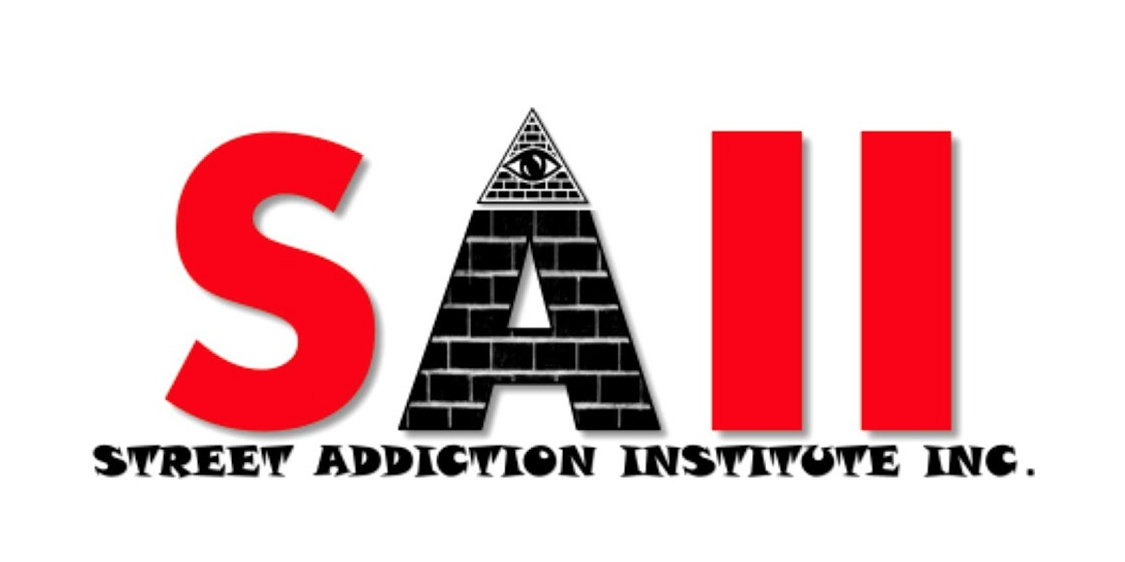 Next steps are for SAII to recruit individuals and families with whom to start working. Jennings-Bey and Arnett will begin recruitment based on their already established relationships in the community. Jennings-Bey reports SAII is in stage two of launching, recently completing the business nitty gritty. In mid-April, an office was opened in Peck Hall, a family counseling facility run by SU, which serves as a neutral location for all parties. The center resides in an academic building set off campus and on the edge of downtown.
Next steps are for SAII to recruit individuals and families with whom to start working. Jennings-Bey and Arnett will begin recruitment based on their already established relationships in the community. Jennings-Bey reports SAII is in stage two of launching, recently completing the business nitty gritty. In mid-April, an office was opened in Peck Hall, a family counseling facility run by SU, which serves as a neutral location for all parties. The center resides in an academic building set off campus and on the edge of downtown.
Jennings-Bey also hopes to partner with the courts to take in offenders himself rather than have them immediately incarcerated.
“I hope that they have enough faith in my track record and my relationship with SU to give us those young people first and let us take them through a curriculum,” Jennings-Bey said. “I’m very confident that we can cut back on the recidivism rate, the number of gunshots and the exposure to the whole street/gang culture.”
In 2015, the Syracuse Police Department reported 142 shooting victims, according to data gathered by the Gun Involved Violence Elimination (GIVE) Initiative, which tracks crime, arrest and firearm activity for 20 New York state police departments. GIVE also notes 16 individuals were killed by gun violence last year, compared with 14 the previous year.
A long-term goal is to create a respite house for those injured in community violence. Current research by the team discovered a pattern in neighborhood violence where the names of reported gunshot victims would reappear months later, this time as a shooter. The team determined this by studying neighborhood violence based on public reports dating back to 1995.
Analysis tracking the offenses noted two key findings. First, the neighborhood violence was separate from any reported drug dealings. Second, the names of gunshot victims returned to the police blotter as perpetrators of gun violence. The team identified this as a repetitive pattern and suggested addressing it as a public health crisis. Simply patching up physical wounds or filing criminal charges does not prevent the spread of retaliation shootings.
“We approach this like any communicable disease,” explained professor Lane. “We know that a communicable disease spreads from one individual to another and the strategy is to prevent the spread. Think of it like Ebola.”
A communicable disease affects the poor and marginalized most, and strategies to control these diseases are greatly affected by environmental conditions. Many can be prevented with simple interventions if public health workers act efficiently and effectively. But trying to consider someone to be at risk to be shot or act as a shooter is a very unorthodox view. Yet this is the strategy the Syracuse Neighborhood Violence Research Network is pursuing.
Jennings-Bey believes if this pattern of neighborhood feuding can be interrupted, retaliation of violence by shooting victims will drop. His strategy, after bandaging the gunshot wound, would be to send the victim to his respite center, to prevent the likely future shooting.
He says such a center will create a safe place by removing the individuals from their environment and immersing them in the SAII program.
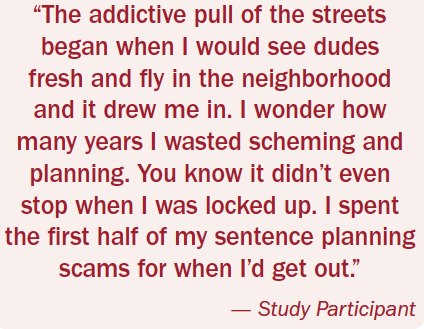 “We as a city and county spend a lot of money on gunshot injuries,” Jennings-Bey said. “So I look at this as a public health issue, affecting the entire community.”
“We as a city and county spend a lot of money on gunshot injuries,” Jennings-Bey said. “So I look at this as a public health issue, affecting the entire community.”
Haygood-El, who was shot five times in the chest and abdomen at the age of 24 because of a dispute in the streets, says he required emergency surgery and an 18-month hospital stay. By age 18, he says he was addicted to the streets and in trouble with the law a number of times because of guns.
His final hospital bill was $65,000, but he says he paid nothing. “Medicaid took care of that. At that time, I was uninsured. I was running the streets, living with girlfriends. I had no money.”
His bill fell on the taxpayers, as do many others since the majority of gunshot victims are uninsured.
During the April 11 presentation, the team shared the estimated cost they determined based on figures reported by the Syracuse Police Department. Their analysis, unlike data compiled in the GIVE report, excludes domestic disputes, focusing instead on what they deem community violence. This is an effort to find patterns to fit their public health analysis. In a paper currently under review, they reported that, based on data from 2006 to 2008, the emergency medical care for each gunshot victim totaled $28,510. Multiplying the estimated cost of each emergency care with the number of victims, which they identified as an instance of community violence, suggests that the total annual price tag for Syracuse is more than $2.5 million.
Instead of using those tax dollars to treat medical traumas, the research team wonders what could happen if those millions were funneled to combat the path that led individuals to neighborhood violence. Jennings-Bey’s nonprofit hopes to disrupt this cycle, with the end goal of cutting Syracuse’s gun violence in half within 10 years.
— Article by Ashley Kang, The Stand director
 The Stand
The Stand

